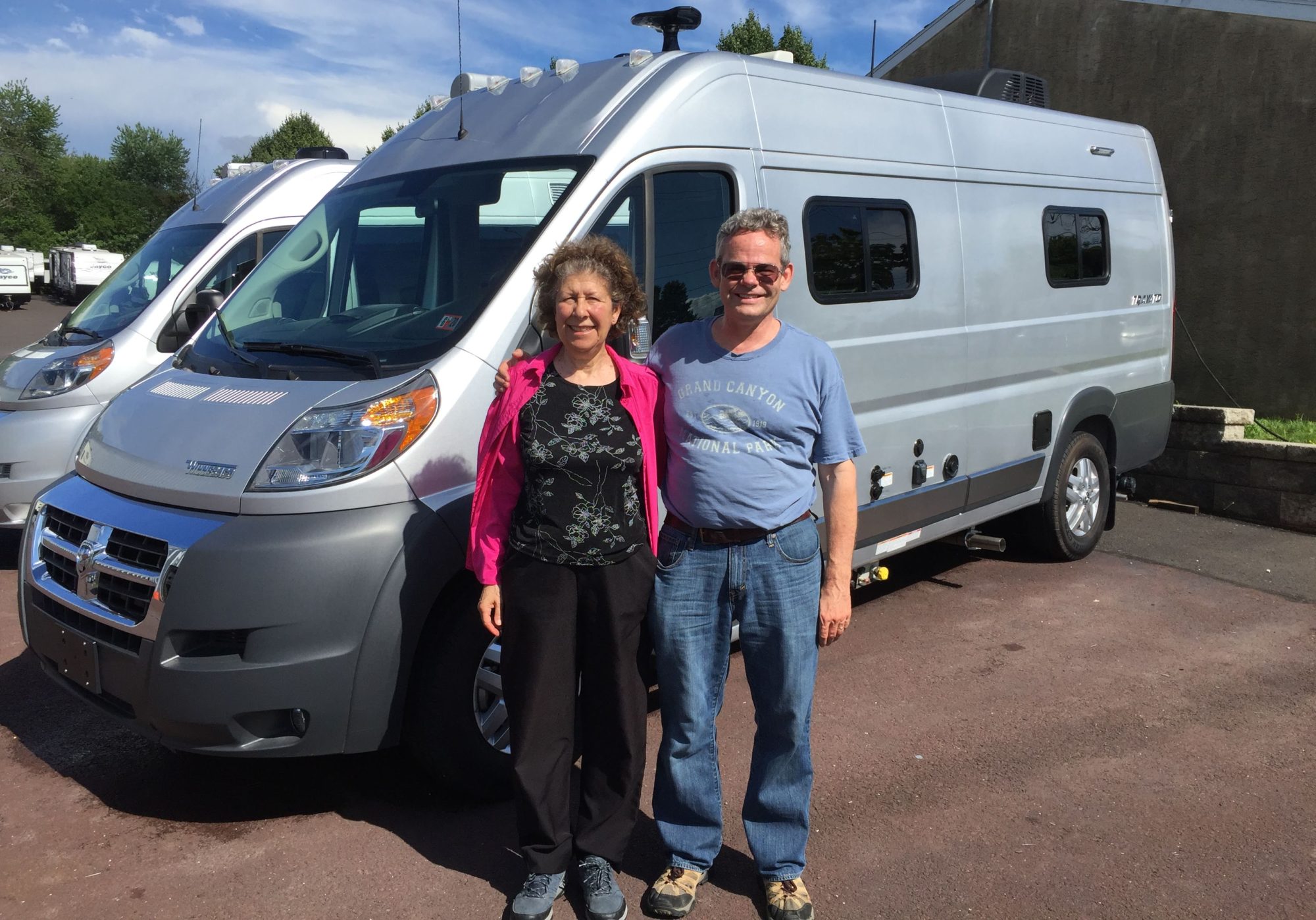Oklahoma City (Oct. 30)
When we started the trip, a two hour haul between campsites seemed like a big deal. Nine months in, the two hours between Tulsa and Oklahoma City seemed short. We had breakfast at one end and lunch at the other.
Actually, it was not a particularly relaxing drive for the driver. As Rogers and Hammerstein said: “Oklahoma, where the winds go sweeping down the plain.” I don’t want to complain when the east coast just got hit by a major wind storm (not to mention all the hurricanes) but in OK, it is windy every day. And windy, with a 12 foot RV on the highway, makes for tense driving.
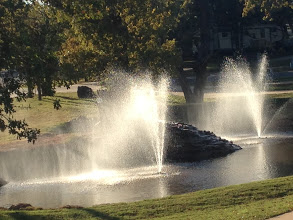 In any case, we are now camped at the Twin Fountains RV Resort just outside OK City. Outside it is windy and cool, but sunny. With the curtains open, inside it is like being in Hawaii. Here is the view from my window of the Twin Fountains. Notice how the wind is whipping the water around!
In any case, we are now camped at the Twin Fountains RV Resort just outside OK City. Outside it is windy and cool, but sunny. With the curtains open, inside it is like being in Hawaii. Here is the view from my window of the Twin Fountains. Notice how the wind is whipping the water around!
Arriving early gave us a chance to spend the afternoon relaxing. Just before dinner, we played a round of mini-golf at the deceptively difficult course at the campground. It did not really look like much, but every hole had weird bumps. There were several holes which neither of us completed within the 6 stroke limit.
The RV park is close to several museums. On Tuesday we decided to go to the American Cowboy and Western Heritage Museum. This huge museum includes many galleries including modern takes on “traditional cowboy crafts” such as leatherwork, silverwork and rawhide braiding, art about cowboys and the west, Native American history and life, cowboy life – both historic and modern, movie and TV westerns and more.
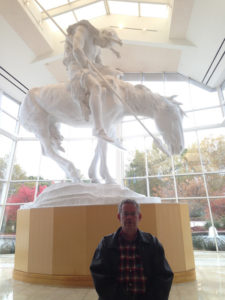 The first exhibit as you walk in is this huge sculpture named “The End of the Trail” by JE Fraser. I thought this referred to the Trail of Tears, but apparently the title was much more politically fraught. Fraser thought that Native American cultures were doomed, and this was his way of depicting it. There is an explanatory note on both walls – one from Fraser’s perspective and one from the Native American perspective, noting that Native American cultures have survived and are thriving.
The first exhibit as you walk in is this huge sculpture named “The End of the Trail” by JE Fraser. I thought this referred to the Trail of Tears, but apparently the title was much more politically fraught. Fraser thought that Native American cultures were doomed, and this was his way of depicting it. There is an explanatory note on both walls – one from Fraser’s perspective and one from the Native American perspective, noting that Native American cultures have survived and are thriving.
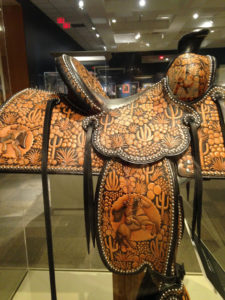 The first gallery that we viewed had modern cowboy crafts – primarily leatherwork like this amazing saddle, silver work, and rawhide plaiting. The other galleries that we saw included TV cowboys, a rodeo, including a history of women rodeo performers, cowboy life in the late 1800s in various parts of North, Central and South America,
The first gallery that we viewed had modern cowboy crafts – primarily leatherwork like this amazing saddle, silver work, and rawhide plaiting. The other galleries that we saw included TV cowboys, a rodeo, including a history of women rodeo performers, cowboy life in the late 1800s in various parts of North, Central and South America,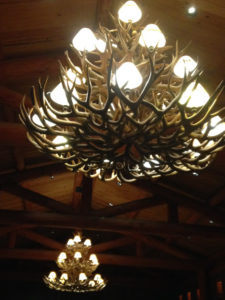 art by and about cowboys and Native Americans, and more. It was very interesting and we were “museumed out” before we could see everything. I was intrigued by these candlebras made from deer (or maybe elk) antlers.
art by and about cowboys and Native Americans, and more. It was very interesting and we were “museumed out” before we could see everything. I was intrigued by these candlebras made from deer (or maybe elk) antlers.
The RV park did not seem to have a lot of kids, so we opted out of Hallowe’en festivities, such as they were, by the simple expedient of leaving our outside lights off.
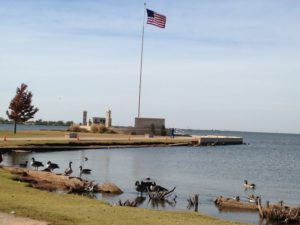 The next day, we both worked in the morning. In the afternoon Chuck decided to stay at the RV, so I took Rumple to Hefner Lake (no relation to Hugh as far as I know) for a walk. On the map, the lake looks like a pond, but it is actually quite large – certainly big enough for sailing. With the strong steady wind, I could see sail surfers in the distance, even though the lake is not big enough to generate waves. There is a biking and hiking path that goes around the perimeter of the lake. However, as is often the case, the path did not afford good views of the lake.
The next day, we both worked in the morning. In the afternoon Chuck decided to stay at the RV, so I took Rumple to Hefner Lake (no relation to Hugh as far as I know) for a walk. On the map, the lake looks like a pond, but it is actually quite large – certainly big enough for sailing. With the strong steady wind, I could see sail surfers in the distance, even though the lake is not big enough to generate waves. There is a biking and hiking path that goes around the perimeter of the lake. However, as is often the case, the path did not afford good views of the lake. 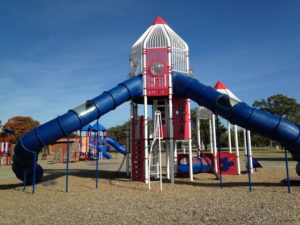 Instead, Rumple and I branched off to a number of side-paths which took us through woods and brush and closer to the water. I parked at Stars and Stripes Park. I guess I am still Canadian enough to be amused at the “over the top” color scheme of the playground at the park.
Instead, Rumple and I branched off to a number of side-paths which took us through woods and brush and closer to the water. I parked at Stars and Stripes Park. I guess I am still Canadian enough to be amused at the “over the top” color scheme of the playground at the park.
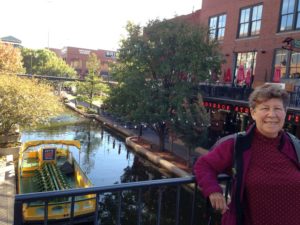
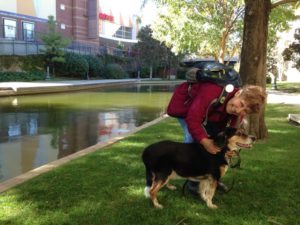 Downtown Oklahoma City has been renovated by creating a small canal from the Oklahoma City through, Bricktown, the older part of the city. The canal connects the softball stadium with the Convention Center.
Downtown Oklahoma City has been renovated by creating a small canal from the Oklahoma City through, Bricktown, the older part of the city. The canal connects the softball stadium with the Convention Center. 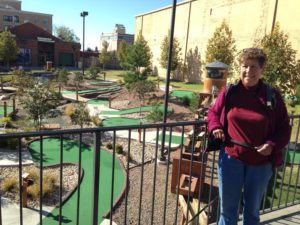 A walkway on both sides of the canal provides a pleasant stroll through the center of the tourist district, and is lined by eateries and hotels and even a downtown mini-golf course.
A walkway on both sides of the canal provides a pleasant stroll through the center of the tourist district, and is lined by eateries and hotels and even a downtown mini-golf course.
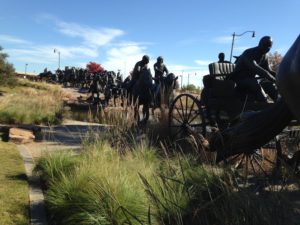 At the farthest end of the canal, near where it meets the Oklahoma River (aka the North Canadian River), is the Land Rush Memorial.
At the farthest end of the canal, near where it meets the Oklahoma River (aka the North Canadian River), is the Land Rush Memorial. 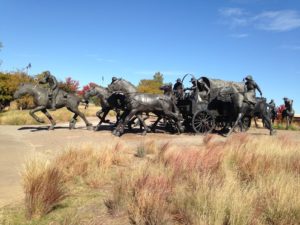
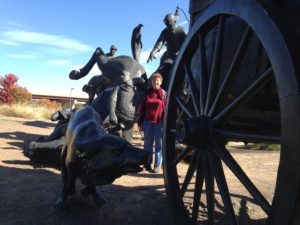 After shoving the Native Americans into ever smaller areas, the federal government found itself with 2 million acres of “unassigned” land. The government announced that the land would be open for claims of 160 acres at noon on April 22, 1899. Although some settlers jumped the gun, and managed to hide out in the “new” territory to stake their claims in advance, an estimated 50,000 potential settlers lined up at the border and set out when the gun was fired at noon. (We met the ancestor of one of the successful settlers a couple of weeks later at a campground. ) The event is commemorated with a monumental set of twice life-sized bronzes of settlers, wagons and their animals. We had not set out to see this memorial, but it is well worth the trip.
After shoving the Native Americans into ever smaller areas, the federal government found itself with 2 million acres of “unassigned” land. The government announced that the land would be open for claims of 160 acres at noon on April 22, 1899. Although some settlers jumped the gun, and managed to hide out in the “new” territory to stake their claims in advance, an estimated 50,000 potential settlers lined up at the border and set out when the gun was fired at noon. (We met the ancestor of one of the successful settlers a couple of weeks later at a campground. ) The event is commemorated with a monumental set of twice life-sized bronzes of settlers, wagons and their animals. We had not set out to see this memorial, but it is well worth the trip.
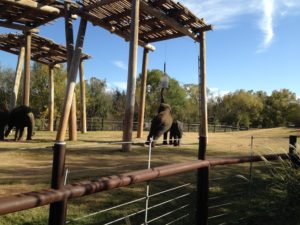
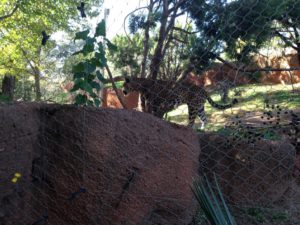
After lunch in Bricktown, we dropped Rumple at the RV, and headed out to the Oklahoma City Zoo. (Our membership in the Columbia SC zoo got us in for half price, which was nice.) We enjoyed the ambience and the animals. We spent quite a long time watching their troop of gorillas and also enjoyed watching the elephants reach for food in this overhead feeder. We always enjoyed watching the big cats.
Oklahoma City was the first place we encountered the great-tailed grackle, a spectacular irridescent black bird, larger and much more talkative than the common grackle. They make a varied assortments of screeches, whistles and gracking. There were hundreds of these noisy and melodious birds in the bushes of the zoo, which made it sound like one was walking through a tropical rainforest.
All in all, a very good zoo.
We definitely could have spent more time in Oklahoma City. For example, we missed the American Pigeon Museum (just up the street from the campground), the Banjo Museum in Bricktown and the memorial to the Oklahoma City bombing.
